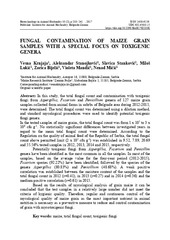Приказ основних података о документу
Fungal contamination of maize grain samples with a special focus on toxigenic genera
Kontaminacija uzoraka zrna kukuruza gljivama s posebnim osvrtom na toksigene rodove
| dc.creator | Krnjaja, Vesna | |
| dc.creator | Stanojković, Aleksandar | |
| dc.creator | Stanković, Slavica Ž. | |
| dc.creator | Lukić, Miloš | |
| dc.creator | Bijelić, Zorica | |
| dc.creator | Mandić, Violeta | |
| dc.creator | Mićić, Nenad | |
| dc.date.accessioned | 2018-12-14T15:12:37Z | |
| dc.date.available | 2018-12-14T15:12:37Z | |
| dc.date.issued | 2017 | |
| dc.identifier.issn | 1450-9156 | |
| dc.identifier.uri | http://r.istocar.bg.ac.rs/handle/123456789/525 | |
| dc.description.abstract | In this study, the total fungal count and contamination with toxigenic fungi from Aspergillus, Fusarium and Penicillium genera of 127 maize grain samples collected from animal farms in subrbs of Belgrade area during 2012-2015, were determined. The total fungal count was determined using a dilution method, and standard mycological procedures were used to identify potential toxigenic fungi genera. In the tested samples of maize grains, the total fungal count was from 1 x 101 to 3 x 106 cfu g-1. No statistically significant differences between investigated years in regard to the mean total fungal count were determined. According to the Regulation on the quality of animal feed of the Republic of Serbia, the total fungal count above permitted limit (2 x 105 cfu g-1) was established in 9.52, 7.89, 20.69 and 55.56% tested samples in 2012, 2013, 2014 and 2015, respectively. Potentially toxigenic fungi from Aspergillus, Fusarium and Penicillim genera have been identified as the most common in all the samples. In most of the samples, based on the average value for the four-year period (2012-2015), Fusarium species (92.22%) have been identified, followed by the species of the genera Aspergillus (80.83%) and Penicillium (48.68%). A weak positive correlation was established between the moisture content of the samples and the total fungal count in 2012 (r=0.41), in 2013 (r=0.27) and in 2014 (r=0.36) and the medium positive correlation (r=0.61) in 2015. Based on the results of mycological analysis of grain maize it can be concluded that the test samples in a relatively large number did not meet the criteria of hygienic quality. Therefore, regular and continuous control of the mycological quality of maize grain as the most important nutrient in animal nutrition is necessary as a preventive measure to reduce and control contamination of grain with mycotoxigenic fungi. | en |
| dc.description.abstract | Ukupan broj gljiva i kontaminacija s potencijalno toksigenim vrstama iz rodova Aspergillus, Fusarium i Penicillium određivani su u 127 uzoraka zrna kukuruza koji su sakupljeni na farmama u okolini Beograda tokom četvorogodišnjeg perioda (2012-2015). Primenom metode razređenja određen je ukupan broj gljiva, dok su standardne mikološke metode korišćene za identifikaciju potencijalno toksigenih rodova gljiva. U ispitivanim uzorcima zrna kukuruza ukupan broj gljiva je bio od 1 x 101 do 3 x 106 cfu g-1. Između ispitivanih godina nisu ustanovljene statističke značajne razlike u prosečnim vrednostima ukupnog broja gljiva. Prema Pravilniku Republike Srbije o kvalitetu hrane za životinje, u hranivima biljnog porekla, ukupan broj gljiva iznad dozvoljenog limita (2 x 105 cfu g-1) ustanovljen je u 9,52, 7,89, 20,69 i 55,56% ispitivanih uzoraka u 2012., 2013., 2014. i 2015. godini, respektivno. Od potencijalno toksigenih gljiva identifikovane su Aspergillus, Fusarium i Penicillim vrste kao najučestalije u svim ispitivanim uzorcima. U najvećem broju uzoraka, na osnovu prosečnih vrednosti u četvorogodišnjem periodu (2012-2015), identifikovane su Fusarium vrste (92.22%), zatim vrste iz rodova Aspergillus (80.83%) i Penicillium (48.68%). Između sadržaja vlage ispitivanih uzoraka i ukupnog broja gljiva ustanovljena je slaba pozitivna korelacija u 2012. (r=0.41), 2013. (r=0.27) i 2014. godini (r=0.36) i srednje pozitivna korelacija (r=0.61) u 2015. godini. Na osnovu dobijenih rezultata mikološke analize zrna kukuruza može se zaključiti da ispitivani uzorci u relativno velikom broju ne zadovoljavaju kriterijume higijenskog kvaliteta. Zbog toga, redovna i stalna kontrola mikološkog kvaliteta zrna kukuruza kao najvažnijeg hraniva u ishrani životinja je neophodna preventivna mera za smanjenje i kontrolu kontaminacije zrna s mikotoksigenim gljivama. | sr |
| dc.publisher | Institute for Animal Husbandry, Belgrade | |
| dc.relation | info:eu-repo/grantAgreement/MESTD/Technological Development (TD or TR)/31023/RS// | |
| dc.relation | info:eu-repo/grantAgreement/MESTD/Technological Development (TD or TR)/31033/RS// | |
| dc.relation | info:eu-repo/grantAgreement/MESTD/Technological Development (TD or TR)/31053/RS// | |
| dc.rights | openAccess | |
| dc.rights.uri | https://creativecommons.org/licenses/by/4.0/ | |
| dc.source | Biotechnology in Animal Husbandry | |
| dc.subject | maize | en |
| dc.subject | total fungal count | en |
| dc.subject | toxigenic fungi | en |
| dc.subject | kukuruz | sr |
| dc.subject | ukupan broj gljiva | sr |
| dc.subject | mikotoksigene gljive | sr |
| dc.title | Fungal contamination of maize grain samples with a special focus on toxigenic genera | en |
| dc.title | Kontaminacija uzoraka zrna kukuruza gljivama s posebnim osvrtom na toksigene rodove | sr |
| dc.type | article | |
| dc.rights.license | BY | |
| dcterms.abstract | Крњаја, Весна; Лукић, Милош; Станојковић, Aлександар; Станковић, Славица Ж.; Бијелић, Зорица; Мандић, Виолета; Мићић, Ненад; Контаминација узорака зрна кукуруза гљивама с посебним освртом на токсигене родове; Контаминација узорака зрна кукуруза гљивама с посебним освртом на токсигене родове; | |
| dc.citation.volume | 33 | |
| dc.citation.issue | 2 | |
| dc.citation.spage | 233 | |
| dc.citation.epage | 241 | |
| dc.citation.other | 33(2): 233-241 | |
| dc.citation.rank | M51 | |
| dc.identifier.doi | 10.2298/BAH1702233K | |
| dc.identifier.fulltext | http://r.istocar.bg.ac.rs//bitstream/id/2264/523.pdf | |
| dc.type.version | publishedVersion |


